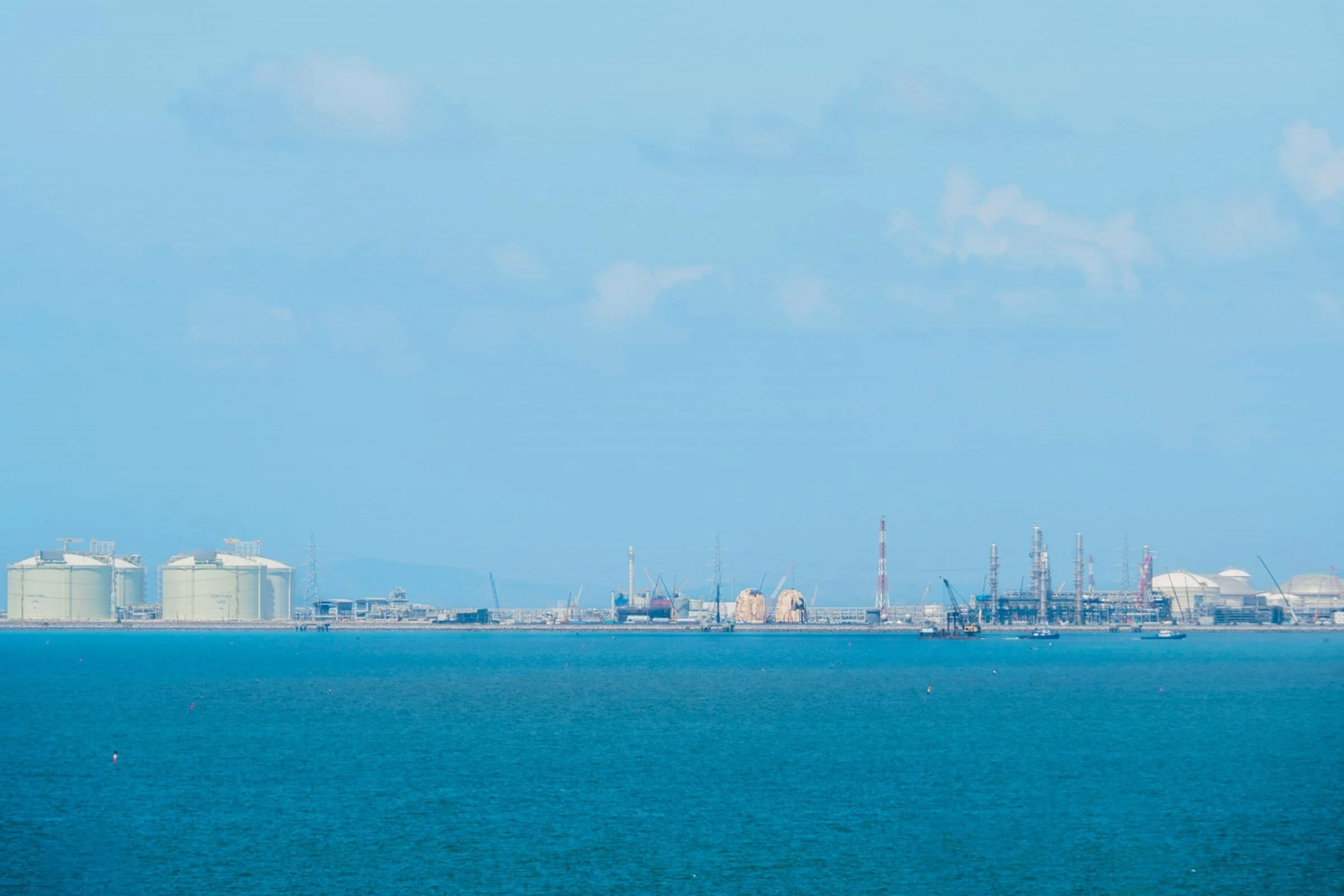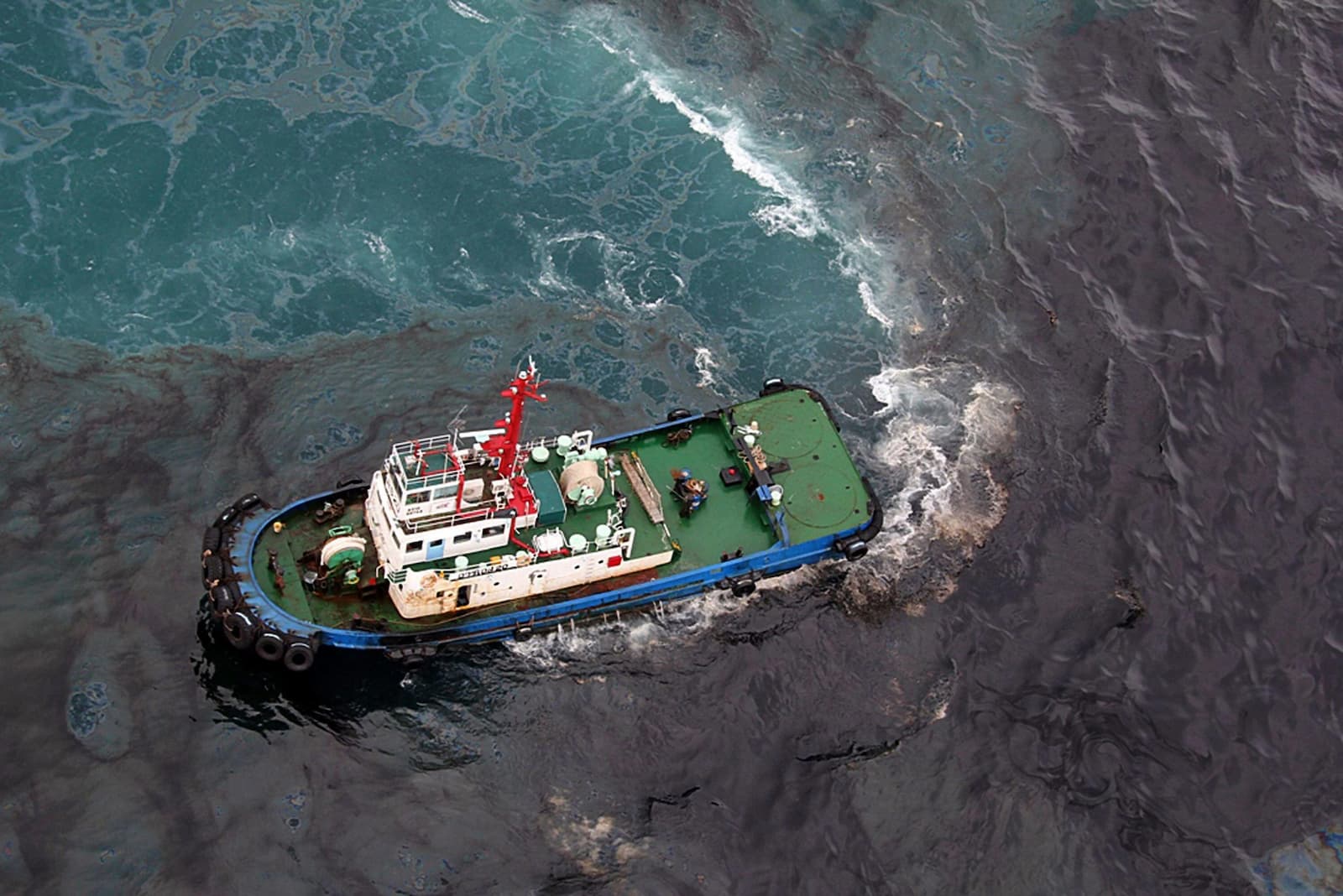Experts call for tighter regulations as Rayong’s environment and fisherfolk pay the price for country’s shift to ‘transition’ fuel

View of an LNG Terminal owned by Thai state-owned energy company PTT in Map Ta Phut, Rayong (Image: P. Ochasanond / Alamy)
Thailand is gradually moving away from coal and oil as part of its goal to achieve carbon neutrality by 2050. A major part of this transition is the expansion of liquefied natural gas (LNG) infrastructure. But though cleaner than coal, LNG is still a fossil fuel, and experts warn that its production and transport are contributing to greenhouse gas emissions.
“If we increase our natural gas production, our share in the global greenhouse gas emissions will be increasing,” said Syed Anees Haider Zaidi, a visiting professor at the University of Warsaw’s faculty of economic sciences who studies the environmental impacts of energy in the Asia-Pacific region.
In the eastern coastal province of Rayong, this LNG boom is also negatively impacting the environment, with campaigners calling for the government to shift its focus to renewables instead.
Thailand’s LNG push
To meet its carbon neutrality target, Thailand aims to increase the share of renewable electricity to 74% of total electricity generation by 2050, from 15% as of April 2025. In the meantime, Thailand remains the largest consumer of natural gas among ASEAN countries, using it to generate electricity, according to a 2025 report from the intergovernmental ASEAN Centre for Energy.
Natural gas, as described by the US Energy Information Administration, is largely composed of methane, and extracted from underground reserves. It can then be converted into LNG for easier transportation and use in electricity generation. Though it emits less carbon dioxide than oil or coal, LNG’s production and use still carry serious environmental risks.
With LNG supplies from the Gulf of Thailand and Myanmar declining as a result of depleted resources as well as the ongoing conflict in Myanmar, Thailand is increasingly reliant on imports from the likes of the Middle East, Witoon Meenet, a researcher at the Mekong Energy and Ecology Network, told Dialogue Earth.
The country’s Power Development Plan 2018-2037 promotes electricity generation from natural gas as a way to maintain economic stability. This is because clean energy technologies are considered quite costly and lacking in investment, according to the ASEAN Centre for Energy. Its report states that while the country works to build up and invest in its wind and solar energy options, natural gas offers a more affordable way of reducing the use of damaging fossil fuels.
LNG is being positioned as a transition fuel, and more countries are seeing natural gas as a bridging fuel with a view to eventually transitioning to renewable sources, said Gerry Arances, executive director at the Center for Energy, Ecology, and Development (CEED) in the Philippines.
Impact on Rayong
Rayong, a province on Thailand’s eastern coast, has become a hub for this energy strategy where, once imported, the country’s LNG imports are re-gasified.
Two LNG terminals operate there: one run by state-owned oil and gas company PTT, and another jointly managed by PTT and the Electricity Generating Authority of Thailand. Rayong also hosts several coal-fired power plants and petrochemical facilities. The province is part of the Eastern Economic Corridor (EEC), a special industrial zone with relaxed regulations to encourage foreign direct investment in vehicles, electronic products and biotechnology.
The more we expand fossil gas in Map Ta Phut – either with a power plant or LNG terminal – the more we see the local community in that area will be exposed to a new threat
- Tara Buakamsri, an advisor to Greenpeace Thailand
It is the biggest industrial estate in Thailand, according to Somnuck Jongmeewasin, research director at EEC Watch, a network of civil society groups. But this industrial concentration has come at a cost: oil spills, air pollution, water contamination and waste have severely affected local communities. Many worry that increased natural gas production will only make things worse.
“For over three decades, the people of Rayong have suffered from severe air and water pollution, oil spills and hazardous waste dumping as a result of unchecked fossil fuel growth,” Chariya Senpong, energy transition campaign team leader of Greenpeace Thailand, said in a statement. “Local communities, particularly fisherfolk and farmers, have seen their health deteriorate, their livelihoods destroyed, and their [lives] threatened.”
Despite the damage, plans are under way to install more gas turbines and build a third LNG terminal in the town of Map Ta Phut in Rayong by 2029.
“The more we expand fossil gas in Map Ta Phut – either with a power plant or LNG terminal – the more we see the local community in that area will be exposed to a new threat,” said Tara Buakamsri, an advisor to Greenpeace Thailand.
Pollution and health impacts
LNG terminals can damage the environment in different ways. Their initial construction disturbs marine life and, post-construction, there is potential for gas leaks – specifically of methane, which is over 80 times more potent than carbon dioxide over a 20-year period, according to the Rocky Mountain Institute. Rayong has already experienced devastating oil spills.

A vessel participating in the cleanup of an oil spill off the coast of Rayong province in 2013, caused by a pipeline leak (Image: Associated Press / Alamy)
An increase in ships delivering the gas also creates more noise pollution, disrupting marine life, and there is potential for water contamination too, according to Arances. He highlighted that scientific testing conducted in various countries found that many pollutant limits have been exceeded in their marine protected areas due to the development of natural gas industries.
Jongmeewasin believes the pollution and contamination has been causing some aquatic animals in Rayong’s waters to dwindle in number and size. As a result, he said, fisherfolk in Rayong have seen steep declines in their catches, pushing them to find other means of work.
In Thailand, the area has become synonymous with pollution, so the province’s tourism industry could also take a hit. Rayong was recently named Asia’s top “slow travel” destination by online travel agency Agoda, but Jongmeewasin believes many local tourists “now go to Pattaya, Trat or Phuket instead”.
There are health risks too. “Fossil gas power plants are one of the major culprits of air pollution, PM2.5. They release nitrogen dioxide pollution from the combustion process,” said Buakamsri, who believes exposure to chemicals are to blame for the higher prevalence of cancers in the area. PM2.5 exposure has been linked to a range of cancers. “People are exposed to carcinogenic chemicals on a daily basis,” said Buakamsri.
Penchom Saetang, founding executive director of the environmental non-profit Ecological Alert and Recovery – Thailand (EARTH), highlights that in Thailand, companies are not required to disclose to the public the quantities of toxic chemicals they release.
“We have some regulations that demand measurements of concentration of some types of air and water pollutants, but the concentrations tell [us] nothing about volume or quantity of the emissions of toxic chemicals, of which there are hundreds released into the environment,” she said. That means a pollutant with a low level of toxicity can be released in high volumes without being disclosed.
Over the years, Rayong communities have protested and filed lawsuits against the government to protect their land from further exploitation and safeguard their health. One lawsuit, filed in 2009, stopped two industry-focused projects from proceeding due to the absence of adequate health impact assessments, and pushed the government to study environmental issues in the area. However, this didn’t stop dozens of other projects from going ahead, often with foreign backing. In 2021, China Petroleum Pipeline Bureau Engineering Co and China Petroleum Engineering won a bid to replace Thailand’s first LNG plant in Rayong with a new one. PTT has also been looking to trade LNG to meet the rising demand coming from China and other Asian countries. The current LNG terminals supply Japanese-backed power plants. Japan is one of the largest investors in LNG production in Southeast Asia.
Redirecting to renewables
Rather than investing further in natural gas, campaigners are calling for the government to focus on renewables.
Arances cited studies that show countries can go straight to renewable energy rather than transitioning from coal to natural gas and then renewable energy sources at a later stage. “That should be the development agenda of Southeast Asia.”
He added: “The sun is always up and it’s really mind-boggling why Southeast Asia doesn’t tap into that resource [more]. And we’re not limited to solar energy. Wind energy is abundant… Some countries are very rich in geothermal. Some countries are very rich in hydro.”
Groups like EARTH are also pushing for the government to establish a Pollutant Release and Transfer Register law, which would mandate companies reporting the quantities of chemical substances they release, including to the public. “If we know that hundreds of factories in Rayong province are emitting beyond the capacity of the area to bear, it will be [easier] for the government and regulatory agencies to control and solve the problem,” said Saetang.
Zaidi, the professor, added that stronger methane regulations are needed. “If we are inviting Chinese, Japanese, or other companies, then we should say: ‘If you are planning to mine in Thailand, or if you are planning to export natural gas, we have these emission standards you need to abide by’,” he said.
Jongmeewasin’s proposed solution is more drastic: halt all new plant construction and scrap the EEC’s special economic rules that allow companies to damage the environment. “The EEC should stop acting like this… and [there should be] no more special economic zone again in Thailand,” he said.
Author: Rebecca L Root
This article was originally published on Dialogue Earth under the Creative Commons BY NC ND licence. Read the original article.
.jpg)



